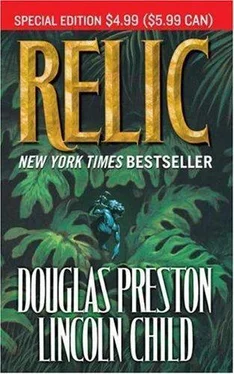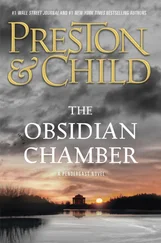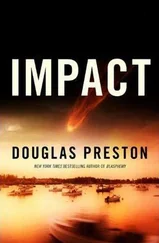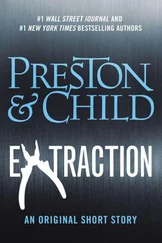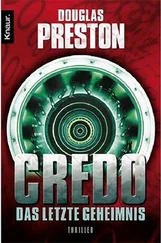Douglas Preston - Relic
Здесь есть возможность читать онлайн «Douglas Preston - Relic» весь текст электронной книги совершенно бесплатно (целиком полную версию без сокращений). В некоторых случаях можно слушать аудио, скачать через торрент в формате fb2 и присутствует краткое содержание. Жанр: Старинная литература, на русском языке. Описание произведения, (предисловие) а так же отзывы посетителей доступны на портале библиотеки ЛибКат.
- Название:Relic
- Автор:
- Жанр:
- Год:неизвестен
- ISBN:нет данных
- Рейтинг книги:3 / 5. Голосов: 1
-
Избранное:Добавить в избранное
- Отзывы:
-
Ваша оценка:
- 60
- 1
- 2
- 3
- 4
- 5
Relic: краткое содержание, описание и аннотация
Предлагаем к чтению аннотацию, описание, краткое содержание или предисловие (зависит от того, что написал сам автор книги «Relic»). Если вы не нашли необходимую информацию о книге — напишите в комментариях, мы постараемся отыскать её.
Relic — читать онлайн бесплатно полную книгу (весь текст) целиком
Ниже представлен текст книги, разбитый по страницам. Система сохранения места последней прочитанной страницы, позволяет с удобством читать онлайн бесплатно книгу «Relic», без необходимости каждый раз заново искать на чём Вы остановились. Поставьте закладку, и сможете в любой момент перейти на страницу, на которой закончили чтение.
Интервал:
Закладка:
“So far,” said Pendergast. “But go easy on me. I’ m a child in these matters.”
“We usually use human DNA as the outgroup, since we’ve mapped so much of it. Anyway, we do a PCR—that is, a Polymerase Chain Reaction—on the sample. This causes thousands and thousands of copies of the genes to be made. It gives us a lot to work with, you see.
He pointed to a large machine with long clear strips of Plexiglas attached to its flanks. Behind the strips were dark vertical bands arrayed in complicated patterns. “This is a pulsed-field gel electrophoresis machine. We place the sample in here, and portions of the sample migrate out along these strips through the gel, according to their molecular weights. They show up as these dark bands. By the pattern of bands, and with the aid of our computer, we can figure out what genes are present.”
He took a deep breath. “Anyway, we got a negative reading on the big cat genes. A very negative reading. It wasn’t anywhere close. And to our surprise, we got a positive reading on the outgroup, that is, Homo sapiens . And, as you know, we identified DNA strands from several species of gecko—or so it appears.” He looked a little sheepish. “But even so, most of the genes in the sample were unidentified.”
“So that’s why you presumed it was contaminated.”
“Yes. Contaminated or degraded. A lot of repeated [158] base pairs in the sample suggested a high level of genetic damage.”
“Genetic damage?” asked Pendergast.
“When DNA is damaged or defective, it often uncontrollably replicates long repeating sequences of the same base pair. Viruses can damage DNA. So can radiation, certain chemicals, even cancer.”
Pendergast had begun to roam around the laboratory, examining his surroundings with an almost catlike curiosity. “These gecko genes interest me a great deal. Just what do they mean exactly?”
“That’s the big mystery,” said Turow. “These are rare genes. Some genes are very common, like the Cytochrome B gene, which can be found in everything from a periwinkle to man. But these gecko genes—well, we don’t know anything about them.”
“What you’re really saying is the DNA didn’t come from an animal, right?” D’Agosta asked.
“Not from any large carnivorous mammal we know of,” Buchholtz answered. “We tested all the relevant taxa. There are not nearly enough matches to say it came from a gecko. So, by a process of elimination, I would say it probably came from a human. But it was degraded or contaminated. The results are ambiguous.”
“The sample,” said D’Agosta, “was found in the body of a murdered boy.”
“Ah!” said Turow. “That could easily explain how it was contaminated with human genetic material. Really, it would be much easier for us if we knew things like this beforehand.”
Pendergast frowned. “The sample was removed from the root canal of a claw by the forensic pathologist, as I understand it, and every effort was made to prevent contamination.”
“All it can take is one cell,” said Turow. “A claw, you say?” He thought a moment. “Let me advance an idea. The claw might be from a lizard that was heavily contaminated by blood from its human victim. Any [159] lizard—not necessarily a gecko.” He looked at Buchholtz. “The only reason we identified some of the DNA as gecko is because a fellow in Baton Rouge did some research a few years ago on gecko genetics, and logged his results in GenLab. Otherwise it would have turned up unknown, like most of that sample.”
Pendergast looked at Turow. “I’d like further tests done to tell us just what those gecko genes do, if you don’t mind.”
Turow frowned. “Mr. Pendergast, the chance of a successful analysis is not all that high, and it could take weeks. It seems to me the mystery’s already been solved—”
Buchholtz clapped his hand on Turow’s back. “Let’s not second-guess Agent Pendergast. After all, the police are paying for it, and it is a very expensive procedure.”
Pendergast smiled more broadly. “I’m glad you mentioned that, Dr. Buchholtz. Just send the bill to Director of Special Operations, FBI.” He wrote down the address on his business card. “And please don’t worry. Cost is no consideration whatsoever.”
D’Agosta had to grin. He knew what Pendergast was doing: getting even for the lousy car. He shook his head. What a devil .
= 24 =
Thursday
At eleven-fifteen Thursday morning, a man claiming to be the living incarnation of the Egyptian pharaoh Toth ran amok in the Antiquities wing, knocking over two displays in the Temple of Azar-Nar, breaking a case and pulling a mummy out of its tomb. Three policemen were necessary to restrain him, and several curators worked the rest of the day replacing bandages and collecting ancient dust.
Less than an hour later, a woman ran screaming from the Hall of Great Apes, babbling about something she’d seen crouched in a dark bathroom corner. A television team, waiting on the south steps for a glimpse of Wright, got her entire hysterical exit on film.
Around lunchtime, a group calling itself the Alliance Against Racism had begun picketing outside the Museum, calling for a boycott of the Superstition exhibition.
Early that afternoon, Anthony McFarlane, a world-renowned philanthropist and big-game hunter, offered a reward of $500,000 for the capture and safe delivery of [161] the Museum Beast. The Museum immediately disclaimed any connection with McFarlane.
All of these events were duly reported in the press. The following incidents, however, went undisclosed to the world outside the Museum.
By noon, four employees had quit without notice. Thirty-five others had taken unscheduled vacations, nearly three hundred had called in sick.
Shortly after lunch, a junior preparator in the vertebrate paleontology department collapsed at her laboratory table. She was taken to Medical, where she demanded extended leave and worker’s compensation, citing severe emotional and physical stress.
By three P.M., security had responded to seven requests for investigations of suspicious noises in various remote sections of the museum. By curfew, police from the Museum command post had responded to four suspected sightings, all of which remained unverified.
Later, the Museum switchboard would tabulate the number of creature-related calls it received that day: 107, including crank messages, bomb threats, and offers of assistance from exterminators to spiritualists.
= 25 =
Smithback eased open the grimy door and peered inside. This, he thought, had to be one of the more macabre places in the Museum: the storage area of the Physical Anthropology Laboratory, or, in Museum parlance, the Skeleton Room. The Museum had one of the largest collections of skeletons in the country, second only to the Smithsonian—twelve thousand in this room alone. Most were North and South American Indian or African, collected in the nineteenth century, during the heyday of physical anthropology. Tiers of large metal drawers rose in ordered ranks to the ceiling; each drawer contained at least a portion of a human skeleton. Yellowed labels were slotted into the front of each drawer; on these labels were numbers, names of tribes, sometimes a short history. Other, briefer labels carried the chill of anonymity.
Smithback had once spent an afternoon wandering among the boxes, opening them and reading the notes, [163] almost all of which were written in faded, elegant scripts. He had jotted several down in his notebook:
Spec. No. 1880-1770
Walks in Cloud. Yankton Sioux. Killed in Battle of Medicine Bow Creek, 1880.
Читать дальшеИнтервал:
Закладка:
Похожие книги на «Relic»
Представляем Вашему вниманию похожие книги на «Relic» списком для выбора. Мы отобрали схожую по названию и смыслу литературу в надежде предоставить читателям больше вариантов отыскать новые, интересные, ещё непрочитанные произведения.
Обсуждение, отзывы о книге «Relic» и просто собственные мнения читателей. Оставьте ваши комментарии, напишите, что Вы думаете о произведении, его смысле или главных героях. Укажите что конкретно понравилось, а что нет, и почему Вы так считаете.
